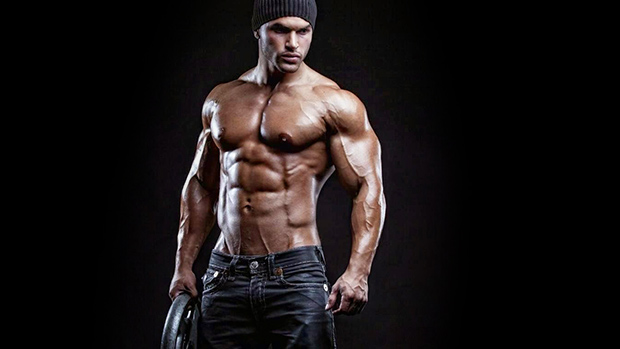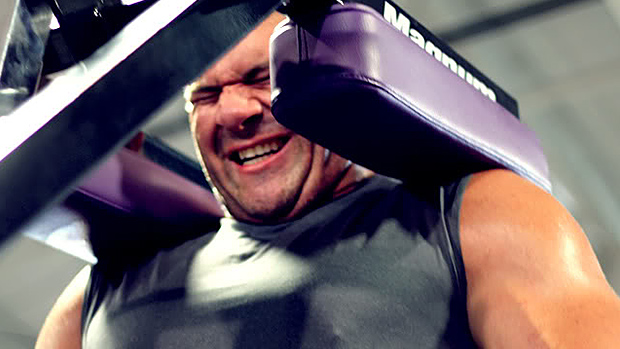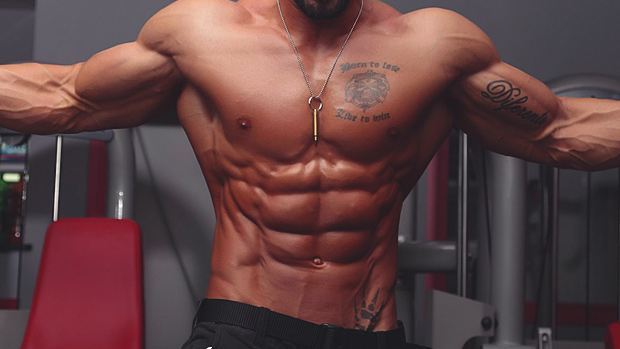Lead Photo: Raciel Castro
Here's what you need to know...
- Hot to Build Stubborn Calves. Pause at the top and bottom of each rep, hold peak contraction at the top of the last rep for 10-20 seconds, and stretch the fascia.
- Increase Chest Responsiveness to Training. Use dumbbells for bench pressing. Press inwards, moving the dumbbells toward each other as you press.
- Build Stronger Traps. Deadlift to activate mTor. For shrugs, go up slowly and squeeze 2-3 seconds at the top of each rep. Shrug as you overhead press.
- Hypertrophy Your Abs. Tense the abs as if you're about to get punched before every rep. Slowly curl the body up, don't bend, and tense hard again at the top.
When it comes to building up a lagging or weak muscle group, the same questions pop up over and over again. While everybody is different, several solutions work for the vast majority of people.
These are some of the most common questions I hear along with the solutions that fix the problem in more than 80% of the cases.
Calves are the hardest muscle group to transform, which is why a lot of people complain about being unable to make them respond.
According to sport scientist Jurgen Weineck, the calves have the lowest trainability of all your muscles. Why? Because they're used extensively during the day (handling your body weight) but more importantly because your body is designed to make walking energy efficient.
Historically, humans had to walk for hours and hours each day. The ankle joint is primarily solicited during that action. If all the effort of propelling your body was provided by a muscular effort of the calves, they'd tire out too fast.
That's why the Achilles tendon is so stiff and strong: it's the stretch-reflex of the Achilles that does a large part of the work at the ankle joint.
The same thing that makes locomotion efficient also makes it hard to make the calves grow. The Achilles has a very strong and highly reactive (easily brought into play) stretch-reflex. When you do regular reps on calf exercises, it's that reflex that does most of the work.
As a result, the muscles themselves don't contribute that much, thus they aren't stimulated optimally.
Furthermore, the range of motion on calf exercises is very short. If you do 8-12 reps, the time in which the muscles are under tension is too short to stimulate maximal hypertrophy – even more so if half of the range of motion is done by the reflexes.
Lastly, the fascia surrounding the calves is the tightest of all the body. The fascia is like an envelope surrounding the muscle. If it's too tight it can actually limit muscle growth.
The Solution for Puny Calves

- Take the stretch-reflex out of the equation. A 2-3 seconds pause in the stretched position can greatly inhibit the stretch-reflex. The stretch reflex is activated to protect you from tearing yourself apart. A sudden stretch is what activates it. If you pause in the stretched position, your body sees the situation as safe and under control and the reflex will be inhibited. By pausing at the bottom of each rep you shift the work mostly to the muscles.
- Initiate the concentric (going up) portion of the movement slowly. You just de-activated the stretch-reflex by pausing, don't reactivate it by jerking the weight up in a stretched position! The first inch of movement should be slow.
- Extend the time under tension. Do 10-12 reps for calves, but hold the peak contraction for 2 seconds on each rep, actively squeezing the muscle as hard as you can. That will extend the TUT up to around 30 seconds per set. On your last rep, hold that peak contraction for 10-20 seconds. That takes care of the time under tension issue.
- The last element is the fascia tightness. The best cure for that is loaded stretching when the muscle is pumped – not to mention that loaded stretching activates mTor which plays a huge role in muscle growth. So after your set is done, get out of the calf machine for 3-5 seconds, just to let blood and fluids inside the muscle, then go back on the machine and hold the low/stretched position for 30-45 seconds.
Do each set like this:
- Perform 10-12 reps with a 2 second stretch at the bottom and a 2 second peak contraction at the top.
- On your last rep, hold the peak contraction for 10-20 seconds.
- Get out of the machine, wait 5 seconds, and get back on it. Hold the stretch position for 30-45 seconds.
You won't need many sets like this since you just did about ten times the actual work as during a regular set of calf raises! Three sets is all you need.
For full development, perform a standing calf exercise and a seated exercise since they hit different parts of the calf – standing is more gastrocnemius, seated is more soleus.
Unless you're genetically gifted in the chest department, the barbell bench press won't give you a lot of chest growth. For most people it'll end up being more of a triceps or deltoid exercise.
Why is that? Well, the pectorals have several functions. But when it comes to movements similar to the bench press, the main function is either transverse flexion or transverse adduction.
They're similar, but the biggest difference is elbow position. And in both cases the main element is bringing the upper arm toward the midline of the body, horizontally (imagine a dumbbell flye movement).
In a barbell bench press your upper arm is limited in how much it can move toward the midline of your body because you're holding a bar. As such, only the first third of the movement has a significant amount of transverse flexion/adduction.
So the pecs are not directly responsible for a lot of the pressing action – they play the main role in the first third of the movement. Past that first third, the pecs are mostly a fixator that's producing isometric tension. Not totally useless, but not a great way to build size either.
The only way to make a barbell bench press more effective for the chest is to do the bench press in an unsafe manner by pushing the elbows out of their socket (protruding forward) at the top of the movement which gives you a tad more transverse flexion/adduction but mostly a scapular abduction.
But it's a high risk movement for shoulder well-being. Don't do it.
The Solution for Unresponsive Pecs

- The better option to develop the chest with pressing movements is to use a dumbbell bench press.
- I personally like doing barbell bench press, because I like to be strong on all barbell lifts. You can keep it in your program, too. But if you want to stimulate more chest growth, the dumbbell variation is a better option... if you do it correctly.
- Dumbbells allow you to use a greater range of motion because the bar doesn't hit your chest preventing you from going lower. A greater range of motion on pressing exercises allows you to recruit the pecs more because you increase the amount of transverse flexion/adduction you have to do at the beginning of the lift.
Feeling the Pec with Dumbbell Bench Press
- When using dumbbells, most people actually use a shorter range of motion instead of a longer one. Maybe it's ego, but it's also because they don't have the barbell as a gauge to see where they're at in the lift.
- Lifters often use the weight plates on the end of a dumbbell as an indication as when to stop going down. In other words, when the end of the dumbbell begins to reach the shoulder, they stop. This cuts 3-4 inches off of the range of motion. If you want to make the dumbbell bench press effective, you must bring your hands lower than your chest.
- And when you press, press inward. Imagine moving the dumbbells toward each other as you press, almost like a flye. I don't recommend touching dumbbells at the top. Just bring them as close together as possible, which will give you a lot more of loaded transverse flexion/adduction.
Use these performance guidelines for dumbbell bench, and your pecs will be the prime movers in a greater portion of the range of motion.
Here's the obligatory "strong guy" answer: if you want big traps you should deadlift regularly.
In reality, the traps are only contracting isometrically (without movement) during a deadlift, but they're under an intense load while in a stretched position. This is one of the best ways to activate mTor in these muscles. Activating mTor increases protein synthesis which will lead to muscle growth.
Heavy farmers walks will work for that same reason. And explosive lifts like high pulls are also a very good growth stimulus for the traps.
But you can use targeted exercises to make the traps grow, if you do them properly. There are two issues at hand: how you execute each rep and what movements you do.
The first problem people have when they do direct trap exercises like shrugs is similar to the problem they have when training calves: the range of motion is very short.
If you do your reps too fast – which happens when you go too heavy – the muscles won't be under tension for a long enough time to stimulate growth. And it's even worse when people cheat on the way up with their legs in order to shrug more weight.
The Solution for Sucky Traps
- An effective isolation rep for the traps is fairly slow on the way up, includes a 2-3 second squeeze at the top, and is lowered slowly until the traps are stretched.
- And of course, no cheating.
- When doing shrugs, try bending forward just a few degrees. This gives the middle fibers of the traps more play, which will give you more overall thickness. It also seems to put less strain on the levator scapulae, which often gets inflamed when doing shrugs.
- People normally train only one function of the traps: the elevation of the scapula (shrug). But there's another important function: the upward rotation of the scapula.
Watch This Video – the third exercise showcases an upward rotation of the scapula:
While my goal isn't necessarily to have you do that superset, it illustrates both important function of the traps.
- My favorite way to train the upward rotation function of the trap doesn't even require that you add another exercise to your program. When you do overhead presses simply try to shrug at the same time as you press the weight. This works especially well with dumbbell presses for the shoulders.
- As soon as the elbows break the shoulder, start to shrug as you continue to press. This is one of the most powerful ways to stimulate growth in the traps.
Let's assume you're truly lean enough to show good abdominal separation. The problem is that the rectus abdominis (six pack) is underdeveloped.
There is no one miraculous ab exercise. Rather, the important thing is how you do your reps. The body will easily compensate with other muscle groups when trying to work your abs – rectus femoris or psoas for example. People also tend to use too much speed/momentum (because they want to be able to do more reps) which basically kills ab stimulation.
The Solution for Six-Packless Abs

When doing any ab work, your goal should not be to do more reps. It should be to fully fatigue your abs in the least amount of reps possible. Only then will you be efficient at recruiting your abdominals. If you train your abs like this, and you're lean enough, you will get your six-pack to come in.
Here's how you target the six-pack when training abs:
- Before starting, tense your abs hard. Before you begin the movement, tense your abs hard. Imagine you're about to get punched in the stomach. When your abs are tensed hard you can begin the rep.
- Curl your torso up. The concentric portion of the movement should not be a classic sit-up. The key to this movement is to curl (crunch) your torso up. Imagine trying to bring your head to your pelvis. It's also very important to move slowly, and never lose tension in the abs. If you're losing the tension in your abs you're moving too fast.
- Tense your abs hard at the top. On every rep, at the end of the range of motion (when your spine is curled up), tense your abs hard, while still imagining getting punched in the gut.
- Uncurl your torso down. Then go back to the initial position following the opposite pattern (uncurling). Now start over from step one.
- Aim for 8-12 reps, no more. If you can do more than 12 reps, with the exact form described above, you can add some resistance. But remember the goal is to make every rep as hard as possible, not to add weight. Also, try to fatigue your abs in the fewest amount of reps possible.





